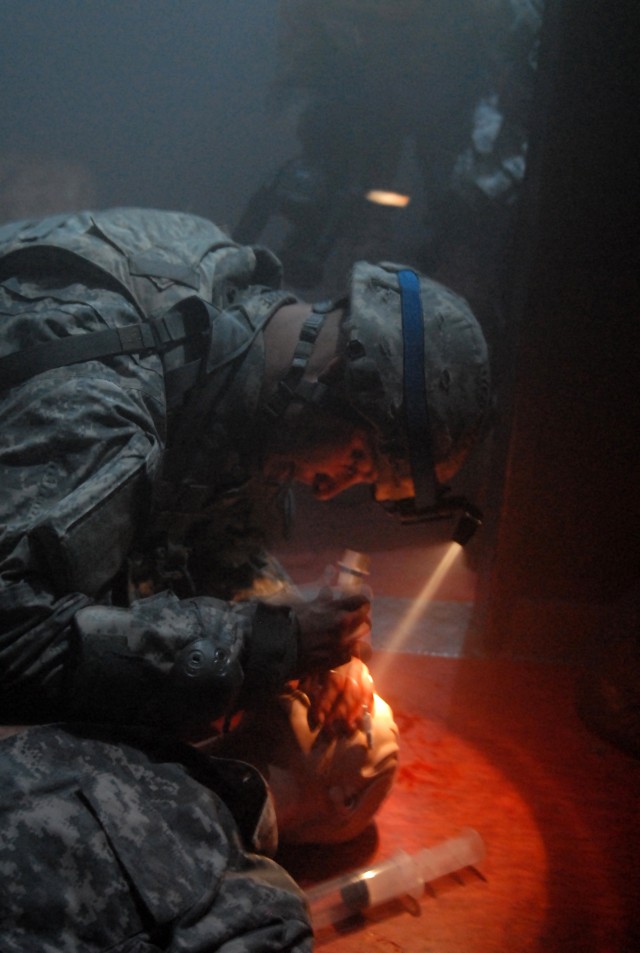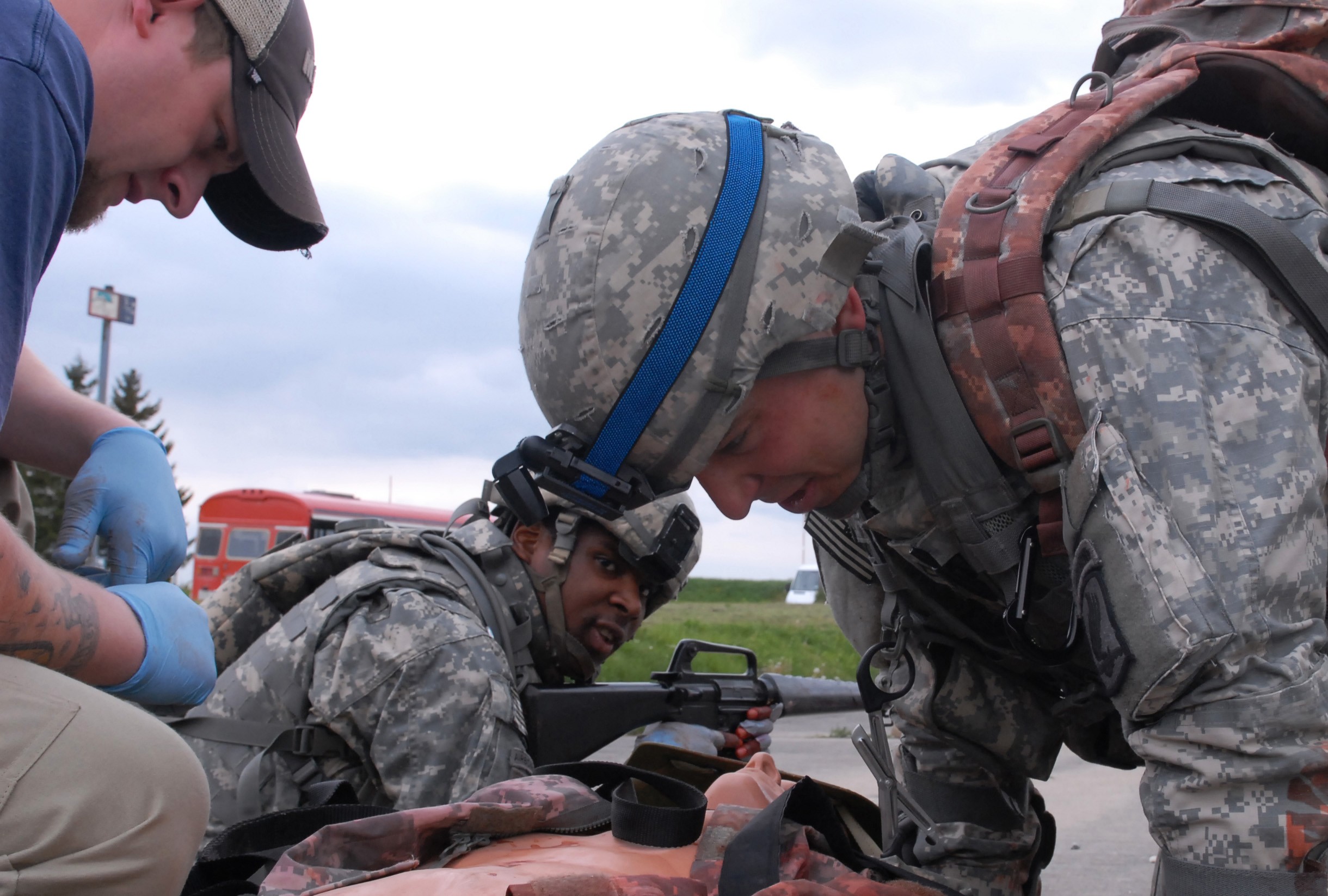VILSECK, Germany - Talk about stress: Imagine treating your fellow "wounded" Soldiers in a smoky "cave" lit by only disco-like strobe lights, trying not to slip in pools of "blood" and "machine gun fire" bouncing off the metal walls. And these "wounded" Soldiers actually breathe, and bleed.
Welcome to the Combat Medic Advanced Skills Training center on the training grounds of the Joint Multinational Training Center. It's one of the most realistic medic training areas in the world, preparing Soldiers for combat among the 21 such facilities in the U.S. Army inventory.
"I think it is a good opportunity," said 1st Sgt. Jason Brooks, Charlie Company, 173rd Brigade Support Battalion based in Bamberg, Germany. "Our medics seem motivated, we just can't replicate this training anywhere else."
Brooks was observing 23 of his company's combat medics run through a Mass Casualty exercise. The battalion is busy preparing for an upcoming deployment.
He noted that this simulation center ensures his Soldiers have to react to the mannequins- not fellow Soldiers playing the part as in years past.
"They actually have to get in there and check the pulses and do interventions themselves," said Brooks.
"Any interventions they do for the casualty, if they do it right the casualty will get better," he added. "If they do it incorrectly, the casualty's condition can worsen and lead to the casualty dying."
Another crucial part of training with these mannequins is actually being able to "torque down" a tourniquet, said Brooks.
Applying a tourniquet to an ordinary mannequin is the first part of the three-part exercise for the medics. The training scenario begins with teams of two Soldiers rushing from a building to a site where there is a casualty lying on a hard plastic sheet. As the instructor shouts "Let's go, what you are going to do, hurry up," the tourniquet is applied.
After applying the tourniquet, the team drags the 175-pound mannequin in a full length, collapsible stretcher made out of hard plastic several yards to the metal shipping container or "cave". This is the Care Under Fire phase. Two, two-inch straps tighten the stretcher around a patient's torso.
Once in the container the heavy metal door was shuts, and the Soldiers' stress level is intentionally sent sky high, beginning the Tactical Field Care Phase.
"You shut the door and it is dark...they can't see anything so it takes them awhile to adjust and sometimes we have people running into the walls. But they eventually get used to the light," said instructor and a former Army combat medic Joe Aubihl.
"It's pretty confusing at first but you just have to maintain your bearing and focus on your job at hand, which is to make sure people don't die," said Pfc. Allen Cote from C Co., 173rd BSB.
Sgt. James Halliburton, also from C Co., added that he and Cote had to low crawl to the patients.
"All the basics come into play, the A-B-Cs," he commented.
The sophistication level of the mannequins also comes into play. One is tethered to a control system that does everything a human does. This includes breathing, blinking, or even having one side of its chest rise up and down. Several pulses are created as well, including radial and femoral.
Aubihl, who served with the Seal Team 4 during Operation Enduring Freedom from 2003 until 2004, said some of these mannequins are also programmed to react to drugs.
When the Soldiers enter the "cave," these mannequins are usually set up with airway blockages or bleeding from their extremities.
To make training even more realistic, a wireless mannequin can be used too. This is hooked up to a laptop held by an instructor. He or she can make vital sign changes on the spot.
The tethered mannequin can be "killed" by shutting off the central air. Aubihl said when this happens, Soldiers do two things. They either say "whatever" or move on or they apply more liquids, dressings or oversplint them.
He said the recommended time for the Soldiers to treat the casualties and evacuate one from the "cave" is 20 minutes.
"We like to push to the Soldiers that time is what kills casualties downrange," he said. "It's that staying and playing and trying to do everything for the casualty you can is what kills them. You're adding time to the death clock... so we try and give them that sense of urgency to bring it down to that 20 minute window."
The third phase in the exercise, the Battlefield Casualty Evacuation, is for the Soldiers to drag the casualty to the same area they drug him from originally. Here they must perform a 9-line MEDEVAC report and verbalize the secondary treatment.
Brooks noted that everything the Soldiers did in treating their casualties was recorded. An After Action Review (AAR) with this data is performed after the exercise.
Halliburton said the most important lesson he learned was to ensure he checked patients from head to toe. "You can't make mistakes; nobody is perfect," Halliburton said, "so here you are going to make mistakes. Just get used to it and realize you're going to make mistakes and get yourself better at doing it."
These recorded mistakes are something that training with fellow "wounded" Soldiers didn't allow.
"The days of the throwing a live Soldier out in the field and putting some tape on him and telling him to shut up... those days are over," commented Aubihl.
For the 173rd BSB's commander, Lt. Col. Curtis A. Johnson, training for a combat mission couldn't be in a better place than the JMTC. About 50 percent of his Soldiers will be deploying overseas for the first time.
"We feel extremely fortunate that we're able to train here at JMTC," he said "(The Soldiers) are working 16, 18 hour days but they're happy to do so and they motivate me each and every day."
Just being able to assist Soldiers in staying alive and keeping their battle buddies alive motivates Aubihl, who admitted that he misses the Army.
"I think that I have more of an impact on Soldiers doing this than being down range or being in the military," he said. "I miss the military, I love the military. I see more numbers through this and I can put out the standard.... This is what you do and this is why you do it, versus some real, real quick hip-pocket training where they take it and they dump it. We can make it real for them so they do take something away from it."
That would be treating your fellow Soldier in the most realistic environment available in Germany.




Social Sharing